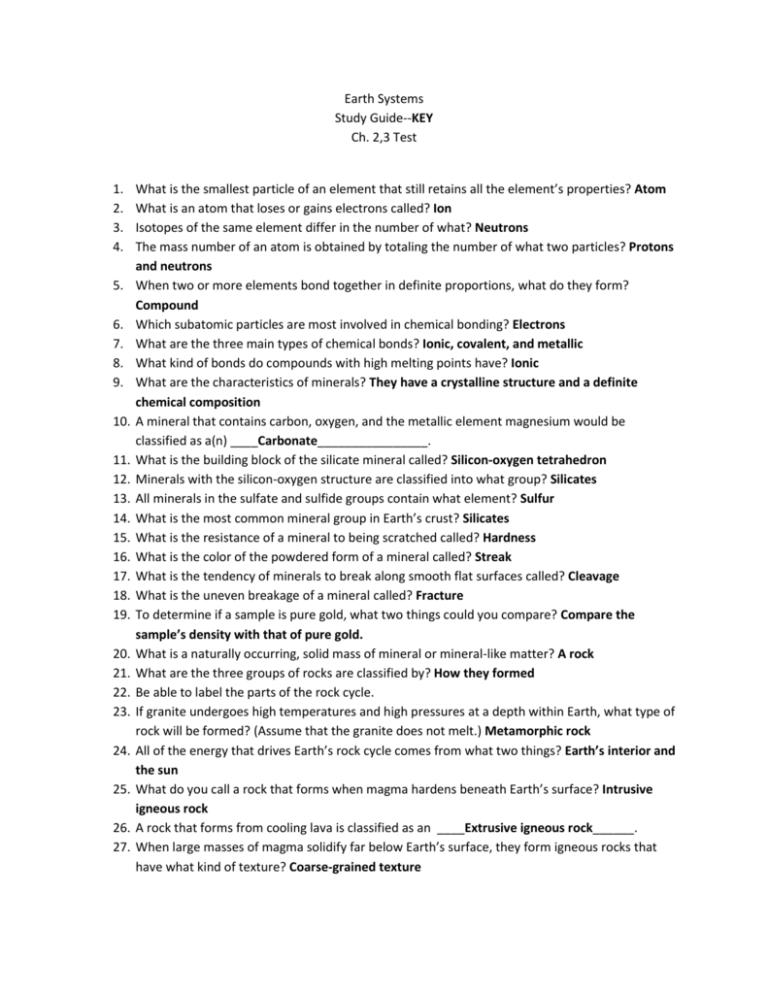Earth Systems study guide ch 2,3
advertisement

Earth Systems Study Guide--KEY Ch. 2,3 Test 1. 2. 3. 4. 5. 6. 7. 8. 9. 10. 11. 12. 13. 14. 15. 16. 17. 18. 19. 20. 21. 22. 23. 24. 25. 26. 27. What is the smallest particle of an element that still retains all the element’s properties? Atom What is an atom that loses or gains electrons called? Ion Isotopes of the same element differ in the number of what? Neutrons The mass number of an atom is obtained by totaling the number of what two particles? Protons and neutrons When two or more elements bond together in definite proportions, what do they form? Compound Which subatomic particles are most involved in chemical bonding? Electrons What are the three main types of chemical bonds? Ionic, covalent, and metallic What kind of bonds do compounds with high melting points have? Ionic What are the characteristics of minerals? They have a crystalline structure and a definite chemical composition A mineral that contains carbon, oxygen, and the metallic element magnesium would be classified as a(n) ____Carbonate________________. What is the building block of the silicate mineral called? Silicon-oxygen tetrahedron Minerals with the silicon-oxygen structure are classified into what group? Silicates All minerals in the sulfate and sulfide groups contain what element? Sulfur What is the most common mineral group in Earth’s crust? Silicates What is the resistance of a mineral to being scratched called? Hardness What is the color of the powdered form of a mineral called? Streak What is the tendency of minerals to break along smooth flat surfaces called? Cleavage What is the uneven breakage of a mineral called? Fracture To determine if a sample is pure gold, what two things could you compare? Compare the sample’s density with that of pure gold. What is a naturally occurring, solid mass of mineral or mineral-like matter? A rock What are the three groups of rocks are classified by? How they formed Be able to label the parts of the rock cycle. If granite undergoes high temperatures and high pressures at a depth within Earth, what type of rock will be formed? (Assume that the granite does not melt.) Metamorphic rock All of the energy that drives Earth’s rock cycle comes from what two things? Earth’s interior and the sun What do you call a rock that forms when magma hardens beneath Earth’s surface? Intrusive igneous rock A rock that forms from cooling lava is classified as an ____Extrusive igneous rock______. When large masses of magma solidify far below Earth’s surface, they form igneous rocks that have what kind of texture? Coarse-grained texture 28. The igneous rock texture that is characterized by two distinctly different crystal sizes is called ____porphyritic _______ texture. 29. As the rate of cooling of igneous rocks increases, what happens to the size of the crystals that form? They decrease in size 30. Igneous rocks that crystallize from magma and are composed almost entirely of quartz and feldspars have what kind of composition? Granitic composition 31. Which sedimentary rock would most likely be deposited in a very high-energy stream? Conglomerate 32. Be able to read a rock classification chart. 33. What type of sedimentary rock is formed from weathered particles of rocks and minerals? Clastic sedimentary rock 34. What is a use for fossils found in sedimentary rocks? Interpreting past environments and matching rocks of the same age found in different places 35. Sedimentary rocks with ripple marks suggest that the rocks formed where? Along a beach or stream bed 36. Where do most metamorphic processes take place? A few kilometers below Earth’s surface 37. Where do metamorphic rocks form? Just below Earth’s surface 38. What is the primary agent of contact metamorphism? (What must it have to occur?) Heat 39. What rock-forming process occurs when hot magma forces its way into rock? Contact metamorphism 40. What changes occur during metamorphism? Crystals may grow larger and certain minerals may recrystallize. 41. List an example of a metamorphic rock that has a nonfoliated texture. Marble 42. A metamorphic rock can be classified according to its ___Texture________ and ____Composition____________. 43. The foliated metamorphic rock that forms when the sedimentary rock shale is subjected to relatively low temperatures and pressures is __Slate________. 44. Fossils are only found in ____Sedimentary_________ rocks. 45. Which metamorphic rocks would most likely have formed at the highest temperatures and pressures? (This is a specific rock). Gneiss 46. Which agent of metamorphism can cause the overall composition of the rock to change? A hydrothermal solution







